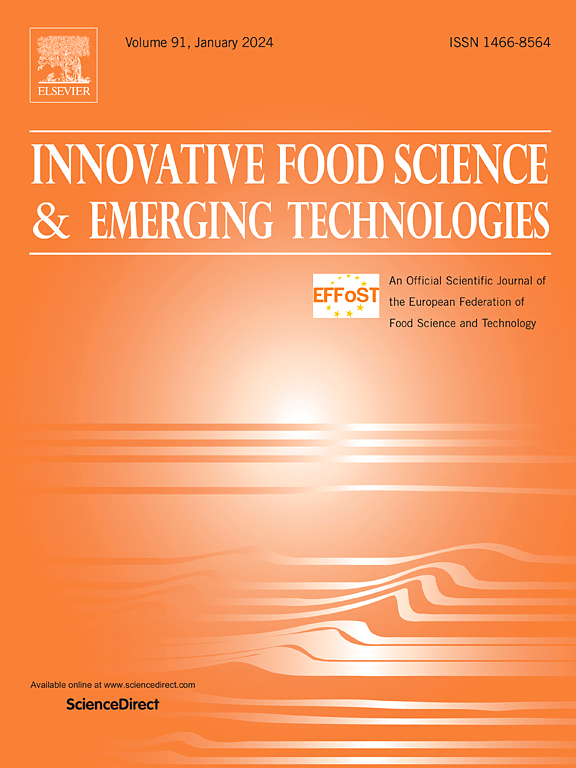脉冲电场释放核桃蛋白中ace抑制肽:多尺度机制-结构-功能研究
IF 6.8
1区 农林科学
Q1 FOOD SCIENCE & TECHNOLOGY
Innovative Food Science & Emerging Technologies
Pub Date : 2025-08-28
DOI:10.1016/j.ifset.2025.104205
引用次数: 0
摘要
在这项研究中,脉冲电场(PEF)处理可以有效地促进核桃蛋白(WP)血管紧张素转换酶(ACE)抑制肽的释放。结果表明,PEF处理通过破坏WP分子间氢键诱导蛋白结构展开和疏水氨基酸暴露,使WP的巯基含量(从11.07增加到15.45 μmol/g)、表面疏水性(从8.64%增加)和溶解度(从36.44%增加到67.85%)增加。超高效液相色谱-电喷雾电离-四极杆飞行时间质谱(UPLC-ESI-QTOF-MS/MS)结果表明,经pef处理的WP (WP- pef)在c端释放含有Phe、Leu、Trp和Pro的肽的潜力比未经pef处理的WP大,其数量分别增加了34、20、7和6。从WPH-PEF酶解物(WPH-PEF)中筛选出8个具有潜在生物活性的肽,这些肽具有良好的硅消化稳定性和良好的生物活性。分子对接分析表明,氢键和疏水相互作用是控制ACE与生物活性肽结合亲和力的主要分子间作用力。此外,网络药理学结果表明,WPH-PEF主要通过调节肾素-血管紧张素系统和改善血管功能障碍来发挥其降压作用。本文章由计算机程序翻译,如有差异,请以英文原文为准。

Releasing ACE-inhibitory peptides from walnut protein via pulsed electric field: A multiscale mechanism-structure-function investigation
In this study, pulsed electric fields (PEF) treatment was demonstrated to effectively enhance the release of angiotensin converting enzyme (ACE) inhibitory peptides from walnut protein (WP). Results showed that PEF treatment induced protein structure unfolding and exposure of hydrophobic amino acids by disrupting intermolecular hydrogen bonds of WP, resulting in increases in sulfhydryl content (from 11.07 to 15.45 μmol/g), surface hydrophobicity (by 8.64 %), and solubility (from 36.44 to 67.85 %) of WP. Ultra-performance liquid chromatography with electrospray ionization–quadrupole–time-of-flight mass spectrometry (UPLC-ESI-QTOF-MS/MS) results indicated that PEF-treated WP (WP-PEF) exhibited a greater potential for releasing peptides containing Phe, Leu, Trp and Pro at the C-terminus than untreated WP, with respective increases of 34, 20, 7, and 6 in their quantities. Eight potential bioactive peptides were selected from WP-PEF enzymatic hydrolysate (WPH-PEF) based on their superior in silico digestion stability and promising bioactivity profiles. Molecular docking analysis demonstrated that hydrogen bonding and hydrophobic interactions served as the predominant intermolecular forces governing the binding affinity between ACE and the bioactive peptides. Furthermore, network pharmacology results suggested that WPH-PEF exerted its antihypertensive effects primarily through modulating the renin-angiotensin system and ameliorating of vascular dysfunction.
求助全文
通过发布文献求助,成功后即可免费获取论文全文。
去求助
来源期刊
CiteScore
12.00
自引率
6.10%
发文量
259
审稿时长
25 days
期刊介绍:
Innovative Food Science and Emerging Technologies (IFSET) aims to provide the highest quality original contributions and few, mainly upon invitation, reviews on and highly innovative developments in food science and emerging food process technologies. The significance of the results either for the science community or for industrial R&D groups must be specified. Papers submitted must be of highest scientific quality and only those advancing current scientific knowledge and understanding or with technical relevance will be considered.

 求助内容:
求助内容: 应助结果提醒方式:
应助结果提醒方式:


